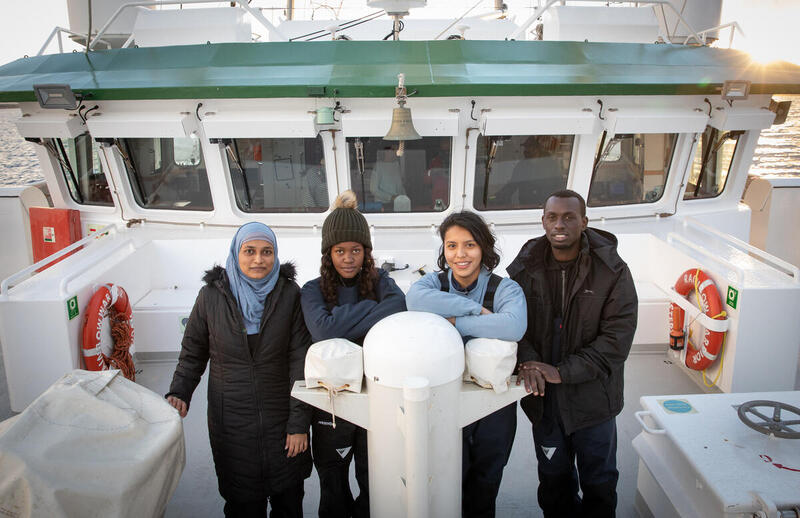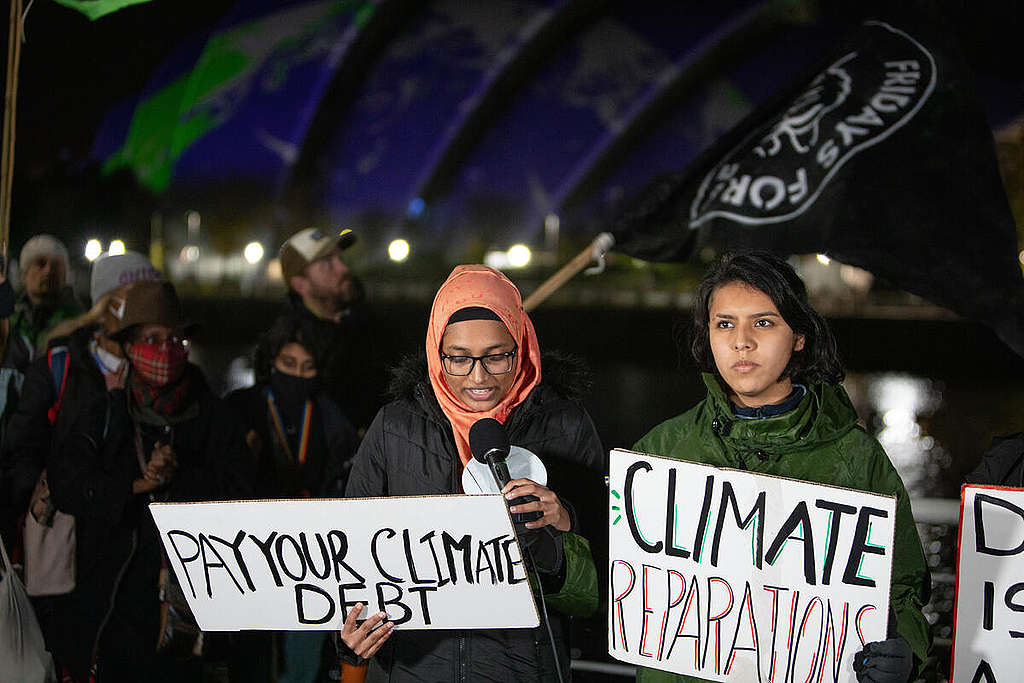Citizen Climate is an on-going series about global citizens taking action, big and small, for the sake of a healthier planet for us all.

The Citizen: Farzana Faruk Jhumu, 22, climate justice activist, Fridays for Future MAPA (Most Affected People & Areas) & FFF Bangladesh
The Action: Attended COP26 to demand justice for those most affected by the climate crisis on behalf of Fridays for Future MAPA, youth climate activists from the Global South. Sailed to the climate summit in Glasgow on Greenpeace’s Rainbow Warrior with three other Fridays for Future youth climate activists from Namibia, Mexico and Uganda.
How did you get started on climate advocacy?
It was in 2007, after Cyclone Sidr, that made a big impact on me and influenced me later in my understanding of climate change. It was one of the biggest cyclones in Bangladesh and it affected a lot of people. It was then that I started thinking that there was something not right about our environment.
In 2017, I started doing community work like cleaning parks, planting trees and using less plastic. Then I started a group teaching underprivileged students in different slums. I visited a slum where many people there were affected by Sidr but even after 10 years their lives have not improved and were in fact getting worse. I tried to understand why they didn’t receive aid after the cyclone and how disasters were impacting the marginalized.
In 2019, I met people from Fridays for Future MAPA and they told me that there was this whole international movement on climate advocacy. I joined the movement and my climate advocacy started from there.
As part of the Fridays for Future MAPA movement, we are trying to make a safe space for people from the Global South who are hit hardest by the Climate Emergency. The people from the Global North have a vision of saving the future but what about the present? As I’m from one of the most affected countries, I wanted to work on a more present-based vision.

Tell us about your journey on the Rainbow Warrior on the way to COP26. How did that happen?
When Greenpeace approached us about joining the journey on the Rainbow Warrior, we had initially hesitated because of the quarantine issues, which would mean missing out on some of our strikes and the global climate strike on October 22. After a lot of discussions, we were told that we should be vaccinated and tested before boarding the ship. I was asked to join the ship and I did. The crew were very helpful and they discussed everything with us, about what we were doing and how to make the journey better or safer.
There was a lot of uncertainty during the journey as we were not sure what was going to happen or whether we could sail all the way to the venue. There were a lot of discussions between the police, port authorities and the ship’s crew. The captain was awesome, though, she said she could do it and if the activists were okay with it, we will go as far as we can go. So it was all quite exciting.
What was your experience at COP26?
I am a student of computer science and engineering so I should not be the one who had to go to COP and teach our global leaders how to do their jobs. Civil society is doing their job, everyone is doing their job. But global leaders are not doing their jobs and instead of fighting for the climate, are actually supporting fossil fuels companies responsible for the crisis.
Despite the challenges of travel restrictions and vaccine inequalities, Global South activists worked hard to be at the summit and to have their voices heard. I think the governments, who were in a closed room with their hot coffee, actually felt the presence of the activists from the Global South. I personally feel that they must have realized that okay, people are watching our every step so we need to be careful about what we are doing.
However, we could not achieve as much as we would have liked. There should have been more talk about pressing issues like the climate debt crisis, about the loss from damages from day one, instead they were fighting over where to put a comma. So that’s very frustrating to make it this far and not be given enough opportunities to talk and make our voices heard.
There was another scenario where the cops were constantly following some of the activists around the conference. We always had this fear of losing our badges.

How important is Youth Advocacy in this climate movement?
Youth advocacy is very important and crucial for the movement. As the youth, we see our present and future being destroyed. There is not a point where we can accept the greed of adults. Very important historical justice movements have always started with the youth who are less afraid of the system and who are willing to question oppression. If we do not question the system, nobody will. Being in a youth movement, I have seen how the youth can be creative and vocal while taking the initiative to teach others.
Tell us about the Global Climate Strike taking place on 25 March. What is the theme #PeopleNotProfit about and how can people get involved?
As you know, FFF organizes global climate strikes in over 120 countries. This time we are all joining together on 25 March. We choose the hashtag #PeopleNotProfit because climate justice is a human rights issue. The recent IPCC reports stated that human action is the cause of climate change which we may be too late in tackling. But we must know that the majority of people are not the ones causing the mass destruction of our planet. It’s some companies and governments backing the companies that are the ones causing the climate crisis. So we demand to put people all over the world as the priority, not just for profit for some.
We believe if we turn away from an injustice to one person, it can turn into injustice for humankind. So we respect, fight and stand in solidarity with everyone to fight against all oppression. This is a fight for everyone, so we welcome everyone to join us. Join our climate strike however you can whether it is online or offline, with friends, with family, in whatever creative way you can. Follow FridaysForFuture MAPA and Fridays for Future Bangladesh to know more and to support us.
What are you involved with now?
MAPA is trying to restructure its movement in a way so that everyone can be more active. We are currently not running any campaigns but supporting local campaigns. In my local group, we are campaigning against the Matarbari coal power plant phase 2, which is funded by Japanese companies and that the government is supporting.
You’re taking on a lot on your shoulders. How do you take a break to take care of yourself?
Within the activist community, we always have this fear of missing out on important issues. Like if we take a break, we might miss out on something important that if we don’t engage with, then people will get hurt. It is actually tough for us. But we do need to take a break and we help each other to take time off by keeping each other informed about the highlights of what is happening.
If I’m working on a campaign or a strike, it can seem hard to do it alone but when you have friends and a community to do it together with, it gets easier. They would check in on me, if I’m feeling burnt out or if I’m okay. Sometimes I would feel like I don’t want to take on anything for the day and will take time off and listen to music.
